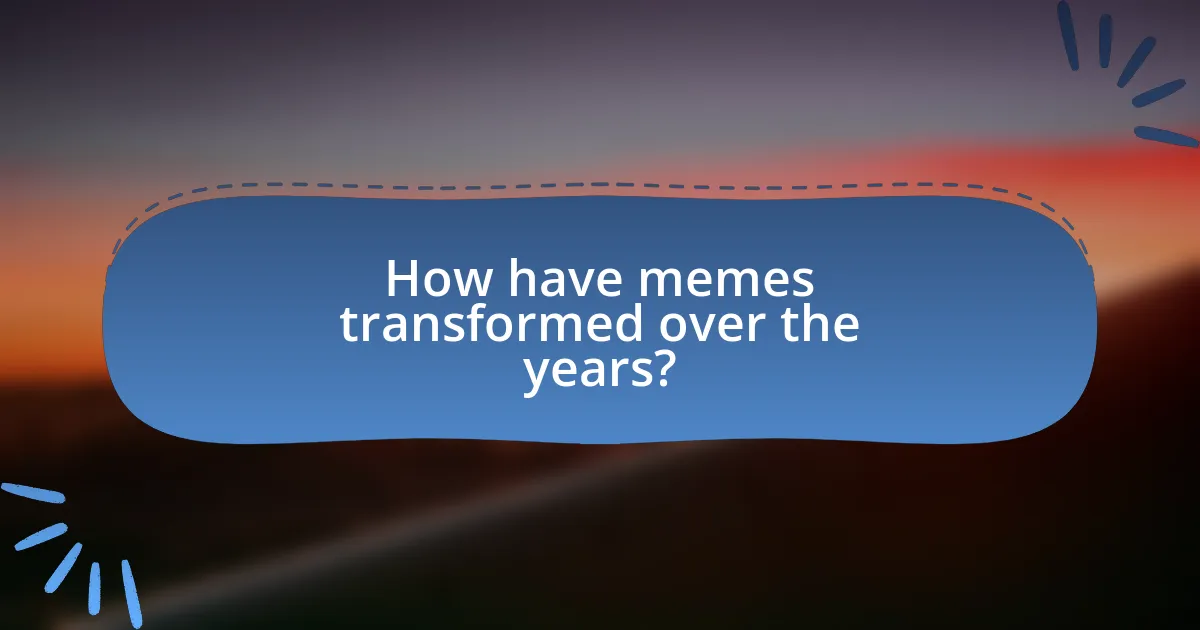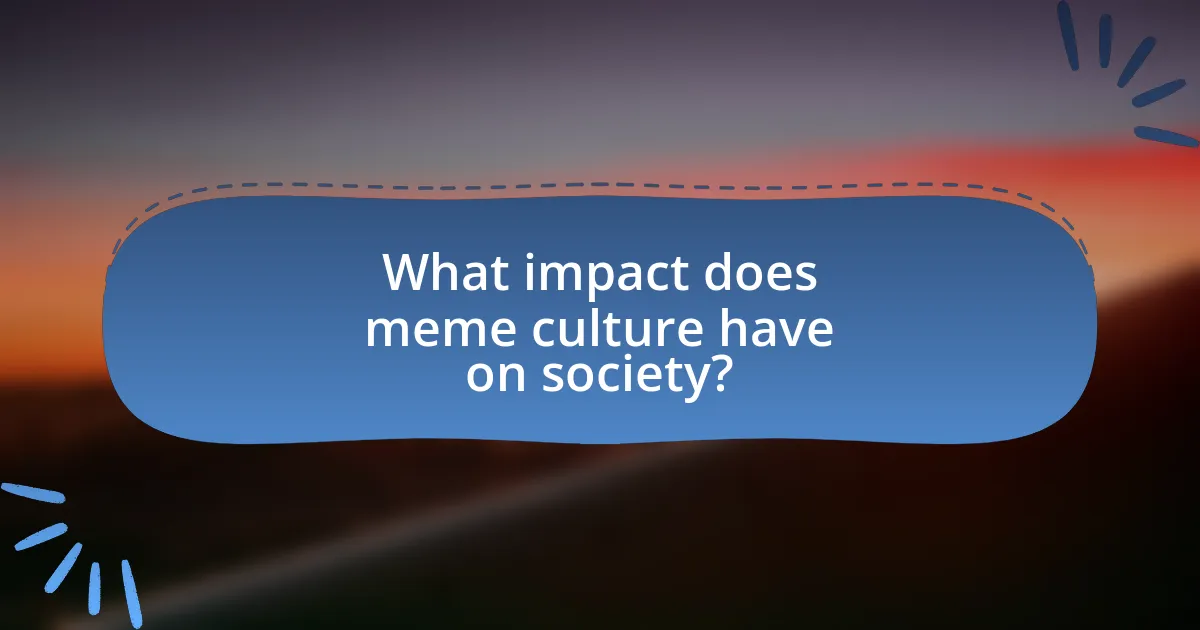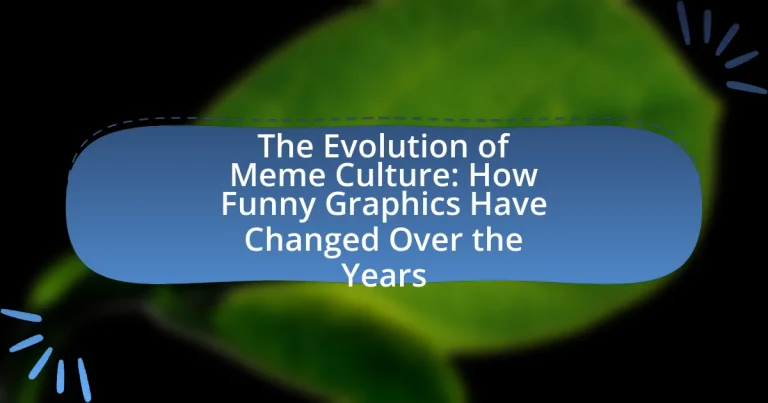The article examines the evolution of meme culture, tracing its origins from the early 2000s with the rise of internet forums and social media platforms to its current status as a significant aspect of digital communication. It highlights key milestones in meme development, including the transition from simple image macros to dynamic multimedia formats, and discusses the pivotal platforms that facilitated this growth, such as 4chan, Reddit, and TikTok. The article also explores how memes reflect societal trends, influence public opinion, and serve as tools for social movements, while addressing the psychological effects of engaging with memes and best practices for their creation.

What is the Evolution of Meme Culture?
The evolution of meme culture began in the early 2000s with the rise of internet forums and social media platforms, where simple images with text became a popular form of communication. Memes like “Doge” and “Pepe the Frog” emerged as iconic representations of internet humor, reflecting societal trends and emotions. As technology advanced, memes evolved from static images to dynamic formats, including videos and GIFs, allowing for more creativity and engagement. The widespread use of platforms like Reddit, Instagram, and TikTok further accelerated meme dissemination, making them a significant aspect of digital culture. This evolution illustrates how memes have transitioned from niche internet phenomena to mainstream cultural artifacts, influencing language, politics, and social movements.
How did meme culture begin and what were its early forms?
Meme culture began in the early 2000s with the rise of internet forums and social media platforms, where users shared humorous images and text. Early forms of memes included simple image macros, such as the “Bad Luck Brian” and “Success Kid” formats, which combined relatable captions with expressive images. These early memes were often spread virally, leveraging platforms like 4chan and Reddit, which facilitated rapid sharing and remixing of content, establishing the foundational dynamics of meme culture that continue today.
What platforms were pivotal in the early spread of memes?
The pivotal platforms in the early spread of memes were 4chan, Reddit, and MySpace. 4chan, launched in 2003, facilitated rapid meme creation and sharing through its imageboards, particularly the /b/ board, which became known for its chaotic and humorous content. Reddit, founded in 2005, provided a community-driven platform where memes could be upvoted and shared widely, particularly in subreddits dedicated to humor. MySpace, which gained popularity in the early 2000s, allowed users to share images and videos, contributing to the viral nature of memes during its peak. These platforms collectively enabled the rapid dissemination and evolution of meme culture in the early internet era.
How did early memes reflect societal trends and humor?
Early memes reflected societal trends and humor by encapsulating the cultural zeitgeist and shared experiences of internet users. For instance, memes like “Bad Luck Brian” and “Success Kid” emerged during the early 2000s, resonating with audiences by portraying relatable scenarios of failure and triumph, respectively. These memes often drew from current events, popular media, and everyday life, allowing users to express collective sentiments and humor in a concise format. The rapid spread of these memes across platforms like Reddit and 4chan demonstrated their role in shaping online communication and community bonding, as they provided a means for individuals to connect over shared laughter and commentary on societal norms.
What are the key milestones in the development of meme culture?
The key milestones in the development of meme culture include the early internet memes of the 1990s, the rise of image macros in the 2000s, and the explosion of social media platforms in the 2010s. In the 1990s, memes like the Dancing Baby and All Your Base Are Belong to Us emerged, showcasing the potential for humor in digital formats. The 2000s saw the proliferation of image macros, particularly on websites like 4chan and Reddit, where formats like LOLcats and Rage Comics became popular. The 2010s marked a significant shift as platforms like Facebook, Twitter, and Instagram facilitated rapid sharing and remixing of memes, leading to viral trends and the mainstream acceptance of meme culture in everyday communication. These milestones illustrate the evolution of memes from niche internet phenomena to integral components of modern digital communication.
Which memes became iconic and why?
Iconic memes include “Distracted Boyfriend,” “Success Kid,” and “Woman Yelling at a Cat,” primarily due to their relatability and versatility in expressing emotions or situations. “Distracted Boyfriend” became iconic for its humorous depiction of infidelity and distraction, allowing users to apply it to various contexts, which led to widespread sharing and adaptation. “Success Kid” symbolizes achievement and perseverance, resonating with audiences who seek motivation, while “Woman Yelling at a Cat” combines absurdity and humor, making it a favorite for expressing frustration or confusion. These memes gained traction through social media platforms, where their easily recognizable formats and universal themes facilitated rapid dissemination and cultural relevance.
How did technological advancements influence meme creation?
Technological advancements significantly influenced meme creation by providing accessible tools for content generation and distribution. The rise of social media platforms, such as Facebook, Twitter, and Instagram, enabled rapid sharing and virality of memes, allowing creators to reach wider audiences instantly. Additionally, advancements in image editing software and mobile applications, like Photoshop and meme generators, simplified the process of creating visually appealing and humorous content. For instance, the introduction of smartphones equipped with high-quality cameras and editing capabilities in the early 2010s led to an explosion of user-generated memes, as individuals could easily capture and modify images on-the-go. This democratization of content creation has transformed memes into a prominent form of digital communication, reflecting cultural trends and societal issues in real-time.
Why is meme culture significant in today’s digital landscape?
Meme culture is significant in today’s digital landscape because it serves as a powerful tool for communication, social commentary, and cultural expression. Memes facilitate the rapid dissemination of ideas and emotions, often transcending language barriers, which enhances their impact in a globalized online environment. For instance, a study by the Pew Research Center in 2021 found that 55% of American adults reported encountering memes regularly, indicating their pervasive presence in daily digital interactions. Additionally, memes can shape public opinion and influence political discourse, as seen during events like the 2016 U.S. presidential election, where memes played a crucial role in shaping narratives and mobilizing voters. This demonstrates that meme culture is not just entertainment; it is a significant aspect of contemporary digital communication and societal engagement.
How do memes serve as a form of communication?
Memes serve as a form of communication by conveying complex ideas, emotions, and cultural references through visual and textual elements. They utilize humor, irony, and relatability to engage audiences, making them effective for sharing opinions and social commentary. For instance, a meme can encapsulate a societal issue or personal experience in a single image and caption, allowing for quick understanding and emotional resonance among viewers. Research indicates that memes can enhance social interactions and foster community by creating shared experiences, as seen in studies like “Memes as a Tool for Social Change” by Limor Shifman, which highlights their role in shaping public discourse.
What role do memes play in shaping public opinion and culture?
Memes play a significant role in shaping public opinion and culture by serving as vehicles for humor, social commentary, and political discourse. They facilitate the rapid dissemination of ideas and sentiments, often reflecting and influencing societal attitudes. For instance, during the 2016 U.S. presidential election, memes became a prominent tool for political expression, with studies indicating that they contributed to voter engagement and the framing of political narratives. Research by the Pew Research Center found that 55% of social media users encountered political memes, highlighting their impact on public perception and discourse.

How have memes transformed over the years?
Memes have transformed from simple text-based images to complex multimedia formats that incorporate video, GIFs, and interactive elements. Initially, memes like the “Doge” and “Bad Luck Brian” were primarily static images with captions, often shared on platforms like Reddit and 4chan. Over time, the rise of social media platforms such as Instagram, TikTok, and Twitter has facilitated the evolution of memes into more dynamic forms, allowing for rapid sharing and remixing. For instance, TikTok has popularized short video memes that often include music and user-generated content, reflecting current trends and cultural references. This shift has been supported by data showing that video content is more engaging, with studies indicating that video posts receive 48% more views than static images. Thus, the transformation of memes over the years illustrates a shift towards more interactive and engaging formats, driven by technological advancements and changing user preferences.
What are the different types of memes that have emerged?
Different types of memes that have emerged include image macros, reaction memes, video memes, and format-based memes. Image macros typically consist of a picture with text overlay, often used to convey humor or commentary, such as the “Distracted Boyfriend” meme. Reaction memes utilize still images or GIFs to express emotions or reactions, like the “Surprised Pikachu” meme. Video memes involve short clips that are edited or remixed for comedic effect, exemplified by formats like “Vine” or TikTok trends. Format-based memes rely on a specific template that users adapt, such as the “Drakeposting” format. These categories reflect the diverse ways in which memes have evolved and adapted to cultural contexts and platforms.
How do image-based memes differ from video memes?
Image-based memes differ from video memes primarily in their format and engagement style. Image-based memes typically consist of a single static image with text overlay, allowing for quick consumption and easy sharing across platforms. In contrast, video memes incorporate moving visuals and audio, which can convey more complex narratives or emotions but require a longer attention span from viewers. Research indicates that image-based memes often rely on visual humor and cultural references, while video memes can utilize timing, sound effects, and editing techniques to enhance comedic impact. This distinction highlights how each format caters to different audience preferences and social media dynamics.
What are the characteristics of viral memes?
Viral memes are characterized by their ability to spread rapidly across social media platforms, often due to their relatability, humor, and shareability. These memes typically feature simple, easily recognizable images or formats that can be adapted to various contexts, making them accessible to a wide audience. For instance, the “Distracted Boyfriend” meme became viral because it effectively conveyed complex emotions in a humorous way, allowing users to insert their own interpretations. Additionally, viral memes often tap into current events or cultural references, enhancing their relevance and engagement. The combination of these elements contributes to their widespread appeal and rapid dissemination, as evidenced by the millions of shares and interactions they receive online.
How has the humor in memes evolved?
The humor in memes has evolved from simple text-based jokes to complex, layered humor that often incorporates irony, absurdity, and cultural references. Initially, memes primarily featured straightforward humor, such as image macros with captions that conveyed a single punchline. Over time, the introduction of formats like reaction memes and remixes allowed for more nuanced expressions, where humor often relies on context, intertextuality, and shared cultural knowledge. For instance, the rise of formats like “Distracted Boyfriend” and “Woman Yelling at a Cat” showcases how humor can be derived from relatable scenarios and layered meanings, reflecting societal trends and collective experiences. This evolution is supported by the increasing complexity of meme formats and the diverse platforms that facilitate their spread, indicating a shift towards a more sophisticated understanding of humor in digital culture.
What themes are prevalent in modern memes compared to earlier ones?
Modern memes predominantly feature themes of irony, self-awareness, and social commentary, contrasting with earlier memes that often focused on simple humor and absurdity. This shift reflects a deeper engagement with cultural and societal issues, as seen in memes addressing topics like mental health, political satire, and identity. For instance, the rise of “dank memes” showcases a blend of humor and critique, often referencing current events or internet culture in a way that encourages reflection. This evolution is supported by the increasing complexity of meme formats and the platforms used for sharing, which allow for more nuanced expressions compared to the straightforward, image-based humor of early memes.
How do cultural references in memes change over time?
Cultural references in memes change over time due to shifts in societal values, trends, and technological advancements. As new events occur and popular culture evolves, memes adapt by incorporating contemporary references that resonate with current audiences. For instance, memes that once referenced television shows or movies may transition to include viral internet challenges or political events, reflecting the interests and concerns of the moment. This adaptability is evident in the rapid turnover of meme formats, where older memes are often repurposed with new contexts, demonstrating how cultural relevance is maintained through constant reinvention.

What impact does meme culture have on society?
Meme culture significantly impacts society by shaping communication, influencing social norms, and driving political discourse. Memes serve as a modern form of expression, allowing individuals to convey complex ideas and emotions succinctly, often using humor or satire. For instance, a study published in the journal “Social Media + Society” found that memes can facilitate social movements by spreading awareness and mobilizing support, as seen during events like the Black Lives Matter protests, where memes played a crucial role in disseminating messages quickly across platforms. Additionally, memes can reinforce or challenge societal norms, reflecting and sometimes altering public perceptions on various issues.
How do memes influence social movements and activism?
Memes significantly influence social movements and activism by facilitating rapid information dissemination and fostering community engagement. They serve as accessible tools for expressing complex ideas, emotions, and social critiques, often using humor or satire to resonate with a broader audience. For instance, during the Black Lives Matter movement, memes like “I Can’t Breathe” became viral symbols, amplifying awareness and solidarity around police brutality. Research by the Pew Research Center indicates that 55% of social media users have engaged with political memes, highlighting their role in shaping public discourse and mobilizing support for various causes.
What examples illustrate memes as tools for social change?
Memes serve as effective tools for social change, exemplified by the “We Are the 99%” meme during the Occupy Wall Street movement, which highlighted economic inequality and mobilized public support. This meme utilized simple graphics and text to convey a powerful message, leading to increased awareness and participation in protests against corporate greed. Another example is the “Ice Bucket Challenge,” which raised significant funds and awareness for ALS, demonstrating how viral memes can drive social action and charitable contributions. These instances illustrate how memes can encapsulate complex social issues and inspire collective action.
How do memes contribute to the spread of misinformation?
Memes contribute to the spread of misinformation by simplifying complex ideas into easily digestible formats that can be rapidly shared and misunderstood. This simplification often leads to the distortion of facts, as memes frequently rely on humor or satire, which can obscure the truth. Research indicates that the visual nature of memes enhances their shareability, making them more likely to go viral, thereby amplifying any inaccuracies they contain. A study published in the journal “Computers in Human Behavior” found that memes can significantly influence public perception, particularly when they are emotionally charged, leading to the acceptance of false narratives as truth.
What are the psychological effects of engaging with memes?
Engaging with memes can lead to various psychological effects, including enhanced social connection, humor appreciation, and cognitive processing. Memes often serve as a form of social commentary, allowing individuals to relate to shared experiences and emotions, which can foster a sense of belonging. Research indicates that humor, often present in memes, can reduce stress and improve mood by triggering the release of endorphins. Additionally, the cognitive processing involved in understanding and creating memes can enhance critical thinking and creativity, as individuals analyze cultural references and societal norms. Studies have shown that frequent engagement with humorous content, such as memes, correlates with increased resilience and coping mechanisms in stressful situations.
How do memes affect our perception of humor and reality?
Memes significantly shape our perception of humor and reality by distilling complex ideas into relatable, often humorous visuals that resonate with audiences. This simplification allows individuals to engage with cultural and social commentary in a digestible format, influencing collective attitudes and beliefs. Research indicates that memes can reinforce stereotypes or challenge societal norms, as they often reflect and amplify prevailing cultural narratives. For instance, a study by Shifman (2014) in “Memes in Digital Culture” highlights how memes serve as a form of social commentary, impacting public discourse and shaping perceptions of reality through humor.
What role do memes play in community building online?
Memes play a crucial role in online community building by fostering shared identity and facilitating communication among members. They serve as a form of social currency, allowing individuals to express humor, opinions, and cultural references that resonate with the group. Research indicates that memes can enhance group cohesion by creating in-jokes and shared experiences, which strengthen bonds among community members. For example, a study published in the journal “Computers in Human Behavior” found that memes contribute to social interaction and engagement, reinforcing a sense of belonging within online communities.
What are best practices for creating impactful memes?
To create impactful memes, focus on relatability, clarity, and humor. Relatable content resonates with audiences, making them more likely to share the meme; for instance, memes that reflect common experiences or emotions often go viral. Clarity ensures that the message is easily understood at a glance, which is crucial given the fast-paced nature of social media consumption. Humor, particularly in the form of wit or irony, enhances engagement, as studies show that humorous content is more likely to be shared (Bennett, 2020, Journal of Internet Memetics). Additionally, using high-quality images and adhering to current trends can increase a meme’s relevance and appeal.
How can one effectively use humor in meme creation?
To effectively use humor in meme creation, one should focus on relatability, timing, and cultural references. Relatable humor resonates with audiences, as it reflects shared experiences or emotions, making the meme more engaging. Timing is crucial; memes that respond to current events or trends often gain more traction due to their relevance. Additionally, incorporating cultural references can enhance humor by tapping into familiar contexts that the audience understands, thus increasing the meme’s impact. Research indicates that humor in memes can enhance social sharing, as people are more likely to share content that elicits laughter or amusement.
What tools and platforms are recommended for meme creation?
Recommended tools and platforms for meme creation include Canva, Adobe Spark, and Imgflip. Canva offers a user-friendly interface with customizable templates specifically designed for memes, making it accessible for users of all skill levels. Adobe Spark provides advanced design features and allows for video meme creation, catering to a more professional audience. Imgflip is a popular online meme generator that enables users to create memes quickly using existing templates and images. These platforms are widely recognized for their effectiveness in meme creation, evidenced by their extensive user bases and positive reviews in digital design communities.

